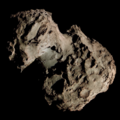C/1955 O1 (Honda)
 Honda's Comet photographed by Paolo Maffei from Italy on 23 August 1955.[1] | |
| Discovery[2] | |
|---|---|
| Discovered by | Minoru Honda |
| Discovery site | Kurashiki, Japan |
| Discovery date | 29 July 1955 |
| Designations | |
| 1955 V, 1955g[3] | |
| Orbital characteristics[4] | |
| Observation arc | 96 days |
| Number of observations | 43 |
| Perihelion | 0.885 AU |
| Eccentricity | 1.00111 |
| Inclination | 107.52° |
| 339.42° | |
| Argument of periapsis | 348.20° |
| Mean anomaly | 0.002° |
| Last perihelion | 4 August 1955 |
| Earth MOID | 0.114 AU |
| Jupiter MOID | 3.233 AU |
| Physical characteristics[5][6] | |
Mean radius | 1.04 km (0.65 mi)[a] |
| Comet total magnitude (M1) | 6.8 |
| Comet nuclear magnitude (M2) | 11.5 |
| 5.0 (1955 apparition) | |
C/1955 O1 (Honda) is a hyperbolic comet that made its closest approach to Earth on 18 August 1955, at a distance of 0.272 AU (40.7 million km).[4] It is one of several comets discovered by Japanese astronomer, Minoru Honda.
Observational history
[edit]Discovery
[edit]Minoru Honda found his seventh comet overall on the night of 29 July 1955,[2] as a diffuse 8th-magnitude object within the constellation Orion.[b]
Follow-up observations
[edit]The comet barely reached naked eye visibility starting on 24 August 1955.[7] By September 1955, it reached peak brightness at magnitude 5.0, believed to be caused by a large outburst that was initially thought to be the comet's fragmentation/splitting event.[8][9]
It was last seen by Max Beyer on 20 November 1955,[10] as a 13th-magnitude object within the constellation Hercules.[6] Elizabeth Roemer and Hamilton Jeffers attempted to recover the comet from the Lick Observatory between February and March 1956 but failed to locate it.[11]
References
[edit]Notes
[edit]Citations
[edit]- ^ P. Maffei (1961). "Osservazioni di Comete. Nota III: Osservazioni fotografiche delle comete 1948g, 1955e, 1955f, 1955g, 1958a". Memorie della Società Astronomia Italiana (in Italian). 32: 113–124. Bibcode:1961MmSAI..32..113M.
- ^ a b M. Honda (1 August 1955). J. M. Vinter Hansen (ed.). "Comet Honda (1955g)". IAU Circular. 1512 (5).
- ^ "Comet Names and Designations". International Comet Quarterly. Retrieved 10 June 2025.
- ^ a b "C/1955 O1 (Honda) – JPL Small-Body Database Lookup". ssd.jpl.nasa.gov. Jet Propulsion Laboratory. Retrieved 23 November 2023.
- ^ a b J. A. Fernández; A. Sosa (2012). "Magnitude and size distribution of long-period comets in Earth-crossing or approaching orbits". Monthly Notices of the Royal Astronomical Society. 423 (2): 1674–1690. arXiv:1204.2285. doi:10.1111/j.1365-2966.2012.20989.x.
- ^ a b c G. W. Kronk (2009). Cometography: A Catalog of Comets. Vol. 4: 1933–1959. Cambridge University Press. pp. 485–489. ISBN 978-0-521-58507-1.
- ^ T. Mitani; E. V. Petersen (25 August 1955). J. M. Vinter Hansen (ed.). "Comet Honda (1955g)". IAU Circular. 1516 (2).
- ^ V. Vanýsek; J. Rajchll (1957). "On a Probable Outburst of Comet 1955 g (Honda)". Bulletin of the Astronomical Institutes of Czechoslovakia. 8: 132–134. Bibcode:1957BAICz...8..132V.
- ^ Z. Sekanina (1979). "Relative motions of fragments of the split comets: III. A test of splitting and comets with suspected multiple nuclei". Icarus. 39 (2): 300–316. Bibcode:1979Icar...38..300S. doi:10.1016/0019-1035(79)90185-4.
- ^ M. Beyer (1959). "Physische Beobachtungen von Kometen. XI". Astronomische Nachrichten (in German). 284 (6): 241–262. Bibcode:1959AN....284..241B. doi:10.1002/asna.19572840602.
- ^ E. Roemer; H. M. Jeffers (June 1956). "Comet Notes". Publications of the Astronomical Society of the Pacific. 68 (402): 278–280. doi:10.1086/126936. JSTOR 40673072.
External links
[edit]- C/1955 O1 at the JPL Small-Body Database




